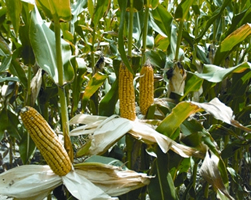Maize
Maize (bhutta) a cereal crop, Zea mays of the family Graminae, order Cyperales. In the United States and Canada maize is known as corn and is considered as an important cereal food crop.
The word maize is derived from the Arawak Indian word ma-hiz. The Spanish equivalent, maiz, is still in use in the Spanish-speaking countries of America. The plant was domesticated and cultivated in the Americas long before the Europeans reached the New World. Little is known about the origin and development of the cultivable variety of maize. It is said that maize was developed through favourable mutation of the wild species Zea mexicana. Subsequently it probably dispersed from Mexico or Central America, its centre of origin, to other countries of the world.

Maize is cultivated in several Asian countries including the Philippines, Thailand, China, India, and Pakistan. In Bangladesh it is cultivated to a limited extent in Kharif and Rabi seasons. The food prepared from maize is not very familiar to the people of Bangladesh, and hence its cultivation is not very extensive. In Europe and America it is one of the major food crops. The people of Mexico, Chile, Central America, and East and South Africa make their principal food items from maize.
The maize plant has a straight pithy noded stalk supported by prop roots. The plant may attain a length like that of sugarcane. The staminate (male) forms the tassel at the top of the plant. The pistillate (female) flowers are the kernels on the cob, which is enclosed by a leafy husk beyond which extend threadlike styles and stigmas. The leaves are elongated and wide and are arranged alternately in two rows. While the upper surface of the leaf bears minute hairlike spines and appears rough, the ventral side is smooth.
Table Production of maize during 2007-08- to 2009-10.
| Year | Area (acre) | Production (m ton) |
| 2007/08 | 5,52,955 | 13,46,471 |
| 2008-09 | 3,17,253 | 7,29,629 |
| 2009-10 | 3,75,628 | 8,87,391 |
Source BBS Yearly Statistical Bulletin, July, 2010.
Maize grows well in sandy loam and heavy clay loam type of soils having pH in between 5.5 and 8.5. A temperature in between 12'C and 29'C seems to be favourable for its growth. Among the high yielding varieties grown in Bangladesh are Savar, JC, DMR, Barnali, Shuvra, Mohar, Khai Bhutta, and Swan-2. A few hybrid varieties are also cultivated in some areas.
Although maize seeds may have different sizes, shapes and colouration; yellow and white colouration are most common. The taste of different varieties also varies widely. In 1997-98, about 6,295 acres of land were under the cultivation of maize in Bangladesh, producing about 2,650 m tons of grains. Bandarban, Rangamati, Dinajpur, and Rajshahi districts are the major maize producing areas. Reports of the Bangladesh Bureau of Statistics show a gradual decrease of annual production of this crop.
Uses A variety of food items are prepared from maize. In fact, it can be used in the same way as rice and wheat. From maize flour alone or mixed with wheat flour or flour of other cereals and pulses bread, mixed parota, pulse puri, soup, mixed food, khichuri, bhutta polao etc are prepared. Immature cobs or seeds can be eaten boiled or fried. Fried mature kernels are used for making many delicious food items.
Maize is also used as a raw material in different industries for production of starch, asbestos board, animal feed, cosmetics, biscuits, horlics, cornflex, confectioneries, edible oil etc. Acetic acid and alcohol are also manufactured from maize.
Pests Several insect pests attack maize in the field. Among these the cutworm (Agrotis ipsilon), shoot fly (Atherigona sp), stem borer (Sesamia inferens and Chilo partellus), aphid (Rhopalosiphum maidis), and the pod borer or earworm (Helicoverpa armigera) are important. In storage, the maize weevil, or the lesser rice weevil (Sitophilus zeamais), and the rice weevil (S. oryzae) may cause serious damage to the kernels if left unprotected.
Diseases Maize is affected by a number of diseases. Of these the following are important: Common smut/Gall smut or Boil smut caused by Ustilago maydis produces gall on the ears, auxiliary buds, tussels, stalks and in rare cases on the leaves. Leaf blight is caused by Drechlera turcicum. The disease is very common and serious in Bangladesh. Noticeable symptoms are seen on the leaf, starting as small yellowish, round or elliptical lesions. Leaf spots caused by Helminthosporium rostratum, H. maydis and H. carbonum show distinct type of leaf spot diseases. They appear less frequently. Rust of maize caused by Puccinia sorgii can be seen in the winter crop.
Other diseases of maize include maize downy mildew caused by Sclerospora phillipinensis; Brown stripe downy mildew caused by Sclerospora rayssiae; Seedling blight and wilt caused by Fusarium moniliformae; Seedling blight and top rot caused by Gibberella zeae; Stalk and ear rot caused by Diplodia maydis; Charcoal rot caused by Macrophomina phaseolina; Bacterial stalk rot caused by Pseudomonas syringae; Bacterial leaf spot caused by Xanthomonas campestris; and Ear rot caused by Cephalosporium acremonium.
Two major virus diseases of maize, caused by maize dwarf mosaic virus (MDMV) and maize chlorotic dwarf virus (MCDV) are transmitted by aphid R. maidis and leafhopper (Graminella nigrifrons) respectively. The later is comparatively more severe. [SM Humayun Kabir and Abul Khair]
